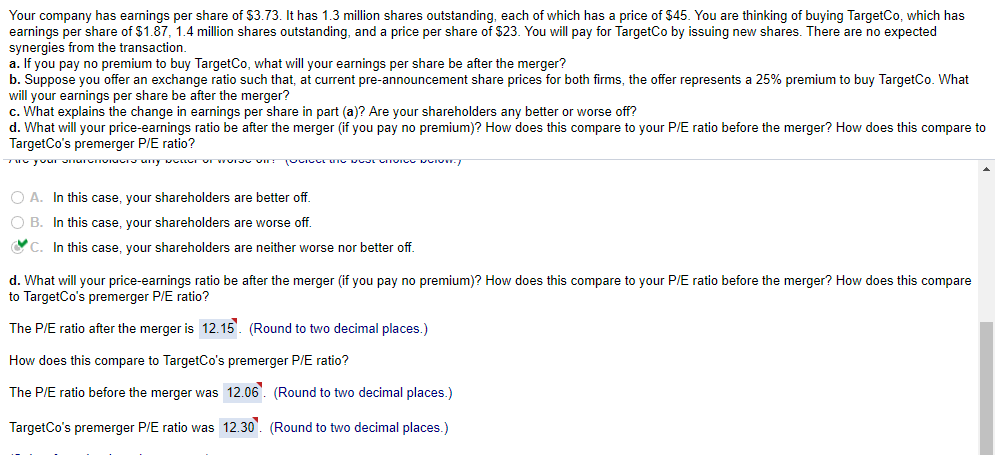Answered step by step
Verified Expert Solution
Question
1 Approved Answer
Can you show me how to solve for question d? Thank you! Your company has earnings per share of $3.73. It has 1.3 million shares

Can you show me how to solve for question d? Thank you!
Your company has earnings per share of $3.73. It has 1.3 million shares outstanding, each of which has a price of $45. You are thinking of buying TargetCo, which has earnings per share of $1.87, 1.4 million shares outstanding, and a price per share of $23. You will pay for TargetCo by issuing new shares. There are expected synergies from the transaction. a. If you pay no premium to buy TargetCo, what will your earnings per share be after the merger? b. Suppose you offer an exchange ratio such that, at current pre-announcement share prices for both firms, the offer represents a 25% premium to buy TargetCo. What will your earnings per share be after the merger? c. What explains the change in earnings per share in part (a)? Are your shareholders any better or worse off? d. What will your price-earnings ratio be after the merger (if you pay no premium)? How does this compare to your P/E ratio before the merger? How does this compare to TargetCo's premerger P/E ratio? your TOIVOT myGLCI I Worm: ICC WTC CITOICO CIW.) O A. In this case, your shareholders are better off. OB. In this case, your shareholders are worse off. C. In this case, your shareholders are neither worse nor better off. d. What will your price-earnings ratio be after the merger (if you pay no premium)? How does this compare to your P/E ratio before the merger? How does this compare to TargetCo's premerger P/E ratio? The P/E ratio after the merger is 12.15. (Round to two decimal places.) How does this compare to TargetCo's premerger P/E ratio? The P/E ratio before the merger was 12.06. (Round to two decimal places.) TargetCo's premerger Ple ratio was 12.30" (Round to two decimal places.) Your company has earnings per share of $3.73. It has 1.3 million shares outstanding, each of which has a price of $45. You are thinking of buying TargetCo, which has earnings per share of $1.87, 1.4 million shares outstanding, and a price per share of $23. You will pay for TargetCo by issuing new shares. There are expected synergies from the transaction. a. If you pay no premium to buy TargetCo, what will your earnings per share be after the merger? b. Suppose you offer an exchange ratio such that, at current pre-announcement share prices for both firms, the offer represents a 25% premium to buy TargetCo. What will your earnings per share be after the merger? c. What explains the change in earnings per share in part (a)? Are your shareholders any better or worse off? d. What will your price-earnings ratio be after the merger (if you pay no premium)? How does this compare to your P/E ratio before the merger? How does this compare to TargetCo's premerger P/E ratio? your TOIVOT myGLCI I Worm: ICC WTC CITOICO CIW.) O A. In this case, your shareholders are better off. OB. In this case, your shareholders are worse off. C. In this case, your shareholders are neither worse nor better off. d. What will your price-earnings ratio be after the merger (if you pay no premium)? How does this compare to your P/E ratio before the merger? How does this compare to TargetCo's premerger P/E ratio? The P/E ratio after the merger is 12.15. (Round to two decimal places.) How does this compare to TargetCo's premerger P/E ratio? The P/E ratio before the merger was 12.06. (Round to two decimal places.) TargetCo's premerger Ple ratio was 12.30" (Round to two decimal places.)Step by Step Solution
There are 3 Steps involved in it
Step: 1

Get Instant Access to Expert-Tailored Solutions
See step-by-step solutions with expert insights and AI powered tools for academic success
Step: 2

Step: 3

Ace Your Homework with AI
Get the answers you need in no time with our AI-driven, step-by-step assistance
Get Started


